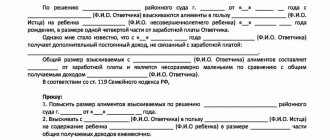Home / Alimony / Simplified procedure for collecting alimony and its meaning
Collect child support without meeting the other parent in court? Spend no more than a working week on the trial? This seems impossible, but such a possibility is provided for by law - in the order of writ proceedings, or, as it is also called, simplified proceedings.
Order proceedings have many advantages, but, unfortunately, they are not suitable for everyone and not in all circumstances. This article is devoted to a detailed analysis of the order for the collection of alimony.
Concept
The simplified procedure for collecting alimony payments is enshrined in Art. 122 Code of Civil Procedure of the Russian Federation. Minors do not have to prove their need in court proceedings. Therefore, to assign alimony to the mother, it is enough to contact the magistrate with an application for the issuance of a court order.
Based on the accepted application and attached documentation, the judge makes a decision on the assignment of payments, and the applicant is issued a court order. In this case, interested parties are not summoned to consider the case. The judge examines the case independently.
How to collect alimony through claims proceedings?
The presented sample can be used when filing applications for the issuance of a court order for the collection of alimony to magistrates of any district or city in the Russian Federation. Be sure to enter all data in full, without abbreviations.
To the magistrate of judicial district No. ____ for the city (district)_____Collector: ________________ (full name, address) Debtor: __________________ (full name, address)Application for a court order to collect alimonyI and _________ (full name of the debtor) are the parents of a minor child (children) _________ (full full name of the children, date of birth). The child (children) live with me, I fully provide for them financially, the defendant has not provided and does not provide financial assistance for the maintenance of children. The defendant has no other children, no deductions are made from him under writs of execution, and we were unable to reach an agreement on the payment of alimony. In accordance with Article 81 of the Family Code of the Russian Federation, in the absence of an agreement on the payment of alimony, alimony for minor children is collected by the court from their parents monthly in the amount of: for one child - one quarter, for two children - one third, for three or more children - half earnings and (or) other income of parents. In accordance with Article 122 of the Code of Civil Procedure of the Russian Federation, a court order is issued if a demand is made for the collection of alimony for minor children, not related to establishing paternity, challenging paternity (maternity), or the need to involve other interested parties. Based on the above, guided by Articles 121-124 of the Civil Procedure Code of the Russian Federation, Ask:
List of documents attached to the application:
Date of application “___”_________ ____ Signature _______ |
Return to menu
┌─────────┐│ SAMPLE │└─────────┘In _________________________ (name of court) Claimant: ________________ (full name /name/, place of residence /location/) Debtor: ___________________ (full name, place of residence)
APPLICATION for the issuance of a court order for the collection of alimony
Based on Art. _________ RF IC citizen _____________________________ (full name of the debtor) is obliged to provide maintenance to _____________________________________________ (full name of the minor child).
The stated claim is confirmed by _____________________________________ (indicate documents confirming the validity of the claim).
The mentioned documents are attached to the application.
The debtor does not pay alimony under a court decision to other persons and does not make payments under other executive documents.
Based on the above, guided by art. ____ RF IC, in accordance with Art. 122 of the Code of Civil Procedure of the Russian Federation, I ask: to issue a court order to collect alimony for a minor child __________________________ (full name of the child) from _________________ (full name of the debtor) in the amount of ___________ from all types of income.
1. Receipt for payment of state duty (original)
https://www.youtube.com/watch?v=https:accounts.google.comServiceLogin
2. A copy of the child’s birth certificate (or passport) - on page _____.
3. Certificate from the debtor’s place of work regarding the amount of wages - on page ______.
4. Certificate from the debtor’s place of work confirming the absence of deductions from him based on a court decision or other executive documents - on ___ page.
5. Certificate of family composition of the debtor - on page ______.
6. Documents confirming that a minor child is a dependent of the claimant - on ______ page.
7. Copies of the application for a court order - on ______ page.
8. Copies of documents confirming the stated requirement - on ____ page.
9. Statement of the debtor’s consent (if it was received before filing the application) with the stated requirements - on ______ page.
10. A document certifying the authority of the representative (if the application was submitted by a representative of the claimant) - on page ______.
Date of application: “___”__________20 __
Signature _______________
(claimant or his representative).
Return to menu
Return to menu
Return to menu
Differences between claim and writ procedures
In accordance with the provisions of the country’s family legislation, 2 methods of assigning alimony are used:
- Voluntary procedure for assigning alimony payments. It implies that parents will independently agree on the amount of financial support for children, its frequency and method of transferring money, without going to court. Parents prepare a draft alimony agreement and send it to the notary. After checking the document, the notary gives it to the parents for signing, after which he puts his signature and registers it in the intradepartmental system. Further obligations are fulfilled according to the conditions specified in the agreement.
- Going to court. If it is not possible to reach an agreement on the fulfillment of alimony obligations, then the potential recipient of alimony payments will need to go to court. For example, a citizen liable for child support lives in another city, does not make contact, refuses to provide financial support to children, or transfers insufficient money and violates deadlines.
When going to court, 2 methods of assigning alimony are used:
- order;
- lawsuit proceedings.
It is enough for a parent to write an application for the formation of a court order if the involvement of other persons (for example, guardianship authorities) is not required and there are no other disputes. Within a few days after receiving the documentation, the court issues an order, which is used as a writ of execution to impose a compulsory order of withholding money for minors.
If there are disagreements on issues related to children, the mother needs to write a claim to the court.
Eg:
- the father refuses to fulfill his alimony obligations or files a counterclaim in court;
- alimony maintenance must be established in a fixed amount;
- the parent needs to collect additional funds from the person liable for child support to meet the needs of the minor;
- it is necessary to change the amount of alimony payments up or down;
- financial support is required for an adult disabled offspring;
- in one claim you need to state several demands (for example, about the dissolution of a marriage, about the place of residence of children, about depriving a parent of rights to a child, etc.).
The duration of legal proceedings in the case of a claim for the assignment of payments can reach 2 months. During the consideration of the case, the parties will need to present arguments, present evidence, participate in debates, and invite witnesses. At the end of the proceedings, the court makes a decision, on the basis of which a writ of execution is formed.
Collection of alimony: step-by-step instructions and features
To assign mixed type payments, the parties can agree to draw up an alimony agreement. If there are disagreements, the parent with whom the child remains must go to court.
Through the court
The procedure for claiming alimony through the court is as follows:
- Documents are being prepared. 2-3 months before filing a claim, it is recommended to start collecting receipts confirming expenses for the child - they will be needed to substantiate claims for the collection of alimony in a fixed amount.
- A statement of claim is being drawn up.
- The plaintiff submits the claim and documentation to the court that made the initial decision on alimony. If they are collected for the first time, you should visit the judicial authority at the defendant’s registered address or at your place of residence.
- The judge accepts the materials for the case within 5 days, then notifications are sent to the parties to the proceedings indicating the date of the first hearing.
- At the hearing, the judge examines the evidence and arguments of the plaintiff and defendant.
- In conclusion, a court decision is made and a writ of execution is drawn up.
If funds were previously collected from the payer through bailiffs, a new writ of execution is transferred to the bailiff conducting the proceedings. In the absence of enforcement proceedings, the claimant has the right to submit a writ of execution to the FSSP to initiate enforcement proceedings or the accounting department at the debtor’s employment address.
How to file a claim?
Plaintiffs can draw up claims on their own without using the form, but their content must comply with the norms of the Code of Civil Procedure of the Russian Federation. The application includes information:
- Full name, registration address, telephone number, date of birth, passport details of the plaintiff;
- Full name, date of birth, residential address of the defendant;
- dates of marriage and divorce;
- dates of birth of children;
- series and numbers of children's birth certificates;
- claims – change the method of collection from equity/firm to mixed;
- description of the grounds for changing the method of collection;
- date of compilation and signature.
By agreement
If the spouses have no disagreements, they have the right to draw up an alimony agreement on the payment of mixed alimony. There are two options here:
- assignment of payments in shares of earnings and transfer of property to pay off alimony obligations;
- appointment in shares and in a fixed amount at the same time.
According to the law, when drawing up an agreement, citizens have the right to independently determine the amount and frequency of transferring funds for child support.
Important! The amount of alimony under the agreement cannot be less than the amount available for collection in court, otherwise the rights of the minor will be violated
How to draw up an agreement?
There is no unified form of alimony agreement. It includes the following information:
- Full name, passport details, registration addresses of the parties;
- data from marriage certificates;
- information about the child (full name, date of birth, etc.);
- method of payment of alimony - cash, bank transfer;
- the amount of payments (in shares + fixed), each is described in detail;
- date of document execution;
- signatures of the parties.
The agreement is subject to notarization. Without a notary's seal, the document is considered invalid.
Advantages and disadvantages
The simplified procedure for collecting alimony payments has its positive and negative sides. Among the advantages are the following:
- the decision is made within 5 days after receiving the documentation;
- The order takes on legal force after 10 days;
- interested parties are not summoned to court;
- you do not need to contact a lawyer to write an application;
- a small list of papers attached to the application;
- the order relates to executive documentation; no writ of execution is required.
Flaws:
- the applicant needs to know the place of work of the person liable for alimony;
- you need a certificate of the debtor’s salary;
- in addition to the assignment of alimony maintenance, the application does not indicate other requirements;
- to challenge the order, the alimony payer may send a corresponding application to the court;
- By means of an order, alimony can be recovered only for children who have not reached the age of majority;
- If the father is already paying child support, then issuing an order is not possible.
Within 10 days from the date of receipt of the court order, the alimony provider may submit an application to the court to revoke the order. In this case, the judge notifies interested citizens in writing within 3 days that the order has lost its force. The applicant will have to file a claim in court to assign alimony support.
Issue rules
The court may assign alimony for minors by issuing a court order if the following points are met:
- Monetary support is established for minor children of the person liable for alimony. Payment of alimony debt and the need for additional cash support are considered as exceptions.
- Financial support is assigned in proportion to the debtor’s earnings. If it is necessary to assign alimony in a fixed amount, then you need to file a claim in court and explain the calculation procedure.
- At the time of filing the application, the person obligated for alimony should not provide financial support to other citizens. In accordance with the law, the maximum amount of alimony withholding from earnings is established. That is, the more claimants, the less money each of them will get. Due to the fact that the amount of monetary support is decreasing, which violates the rights of recipients, the parties are summoned to court.
Conditions
The right to file for alimony in a simplified manner (by way of writ proceedings) is limited.
The following conditions must be met:
- By order, alimony is collected only for the maintenance of minor children.
If there is a need to collect alimony for a wife during pregnancy or maternity leave, for a disabled adult child, for an elderly and needy parent, such cases are considered through a lawsuit.
- There is no dispute regarding recognition of paternity.
Child support can only be recovered from the parent (father) who is indicated on the child’s birth certificate. If the father denies a relationship with the child and therefore refuses to support him, paternity must be established before collecting alimony. Such disputes are resolved through a lawsuit.
- Interested parties – none.
Such persons may be, for example, dependents (other children, wives, parents) who are already receiving payments and whose rights will be affected by additional collection from the alimony payer. Since the rights of these persons must be taken into account by the court, this entails consideration of the case in the manner of claim proceedings (according to paragraph 3 of the Resolution of the Plenum of the Supreme Court of the Russian Federation No. 56 of December 26, 2017).
Example The Chelyabinsk Regional Court canceled a court order for the collection of child support issued by the magistrate court to the claimant Malinovskaya, due to the fact that at the time of its issuance the payer was already paying alimony in the amount of 25% of the salary for a child from his first marriage. The court considered it necessary to involve the claimant under the first writ of execution, Torshina, in the consideration of the case, since the collection of alimony for the second child would entail a reduction in the amount of payments for the first child (from 25% to 16.5%) and would affect his financial rights. The court explained to the claimant Malinovskaya that she has the right to re-apply to the court with a demand for the collection of alimony, but this time through a claim rather than a writ proceeding.
- Alimony is collected exclusively as a percentage of the payer’s permanent income (wages, scholarships, pensions, benefits) in accordance with Art. 81 IC RF.
In order to assign a fixed amount of alimony, the court must examine additional circumstances (the needs of the child, the financial and marital status of the alimony payer). Such circumstances are considered in the procedure of claim proceedings.
Amount of alimony maintenance
A court order may determine the following amounts of alimony payments:
- if there is 1 child – 25% of salary;
- for 2 children – 33% of salary;
- for 3 or more children – 50% of income.
At the same time, legislators divide the income of payers. For some, alimony payments can be withheld, for others - not. If the income of the alimony payer goes to improve the level of financial security and living conditions, then alimony is collected from such income. No withholding is carried out on income received as compensation or to eliminate social problems.
Collection procedure using a simplified method
The assignment of alimony maintenance in the order of writ proceedings proceeds as follows:
- The claimant will need to write a statement.
- Send the application and the documentation attached to it to the magistrate’s court at the place of residence of the debtor or the claimant (to choose from). The package of documentation is handed over in person or sent by mail with notification of receipt and a list of the attached papers. The applicant can also send an official representative with a notarized power of attorney to the court to transfer the papers.
- Waiting for the results of the application review. If the assignment of alimony support was not agreed upon with the payer, the judge may refuse to satisfy the application.
- Take the court order. The applicant may ask the court to forward the order to the bailiffs on paper or electronic media with an electronic digital signature.
Procedure for award and recovery
The procedure for collecting alimony can be divided into 5 stages:
- An application is submitted to the court.
- A lawsuit is being initiated.
- The case is being considered on its merits.
- A court decision is made.
- Bailiffs get involved.
How to apply to court?
The application is submitted to the magistrate's court, and its transfer must be officially recorded. According to the law, you can either come yourself and get a signature on your copy of the application, or send the papers by mail by sending a registered letter.
Upon acceptance of the application, the plaintiff receives a notice with the date and place of the future hearing.
How does collection work?
At the end of the trial, the plaintiff receives a paper; it must be given to the bailiffs, whose task is to actually collect alimony. Their responsibilities include identifying all sources of income for the responsible person:
- If the payer is employed, then the resolution is sent to the place of work. The local accounting department will independently transfer the required amount to the recipient.
- If the payer is officially unemployed, the amount will be deducted from their other available income. A non-working spouse is not at all exempt from paying alimony. Income will be considered: unemployment benefits, pensions, scholarships, in general, everything that can generate profit. In some cases, it is also possible to seize the personal property of a non-working alimony worker.
Since payments in such a situation may be unaffordable for one party or critically low for the other party, it is recommended to resolve this issue peacefully: with the help of an alimony agreement.
Payer abroad
The situation when the defendant lives in the territory of a foreign state is more complicated for the plaintiff. If the defendant’s country of residence is a member of the international convention on mutual legal assistance, then filing a claim is easier and more reliable in Russia.
If not, you will have to go to court at the defendant’s place of residence. In this case, you will have to be guided by the legislation of a foreign country, so a good solution would be to use the services of a law firm.
To file an application for alimony in Russia, the address of the defendant must be known, since the law will require that he be officially notified of the start of legal proceedings.
In order to find out the exact address, you need to submit a corresponding petition, then government authorities will take care of it. To notify the defendant, you will need to send a registered letter; the received receipt will serve as proof of your actions. Then all that remains is to send a petition to the same court for recognition and execution of the decision in another country. The amount of payments will be determined in accordance with local legislation.
Documents for filing a petition for alimony:
- receipt of notification by the defendant;
- court decision (or a copy thereof);
- a document confirming the start of enforcement proceedings;
- a document confirming the defendant’s indifference during the proceedings;
- translation of case materials into the language of a foreign state, certified by a notary.
Writing an application for the formation of an order
The procedure for writing an application is established by Art. 124 Code of Civil Procedure of the Russian Federation. Its structure is similar to a statement of claim for alimony:
- The “header” of the document is placed in the right corner at the top of the sheet. It contains the following information: name and address information for the court district, full name and addresses of interested parties (collector, alimony obligee). If the debtor's registered and residential addresses are different, then both are indicated.
- In the middle part of the sheet is written the heading: “Application for the issuance of a court order for the collection of alimony.”
- The “body” of the application contains the following information: full name and date of birth of minors for whose maintenance funds are needed, the reasons that served as the basis for processing alimony payments. The absence (presence) of defects is indicated. The text of the application must reflect the fact that it is not possible to conclude an alimony agreement. It should also be written that the alimony payer has no other minor children. Below you need to provide links to legislative acts confirming the applicant’s right to a simplified procedure for assigning alimony maintenance.
- Then follows a petition to the court to issue a court order to withhold alimony payments, which must be assigned in a certain proportion of earnings.
- List of documentation confirming the right to receive alimony payments.
- The document ends with the date of preparation and the signature of the applicant.
Download a sample application for a court order to collect alimony
Advantages of a simplified procedure for collecting alimony
The writ procedure is endowed with many advantages, primarily for the claimant and the court. It is designed to simplify and speed up such a routine and, as a rule, indisputable process as the collection of child support, which does not require trial.
So, the order procedure is endowed with the following advantages:
- Short deadlines . Only 5 working days pass from the claimant submitting the application to receiving a court order to collect alimony;
- No trial . The court does not issue subpoenas and does not invite the parties to the court hearing. The case is considered and a decision is made by the court itself.
- A court order is both a court decision on a case and an executive document. If the payer refuses to comply with the court order, he is sent to the FSSP for forced execution with the assistance of bailiffs.
Expert opinion
Semyon Frolov
Lawyer. 7 years of experience. Specialization: family, inheritance, housing law.
This is not to say that the order does not have its drawbacks.
First of all, the ease of canceling a court order. If within 10 days after the issuance of the court order, the payer files an objection, the court will cancel the issued court order.
The case may be sent for re-examination, but in a lawsuit (according to Article 128 of the Code of Civil Procedure of the Russian Federation). After all, an objection by one of the parties (the payer) is already a dispute that requires legal proceedings: presenting arguments, submitting evidence, conducting debates, calling witnesses, etc.
Attached documentation
In order for the application to be accepted for consideration by the court, it will need to be supported by the following documentation:
- civil passports of interested persons (the passport of the alimony provider is attached if available);
- children's birth certificates;
- a certificate of the place of work and earnings of the alimony-obliged citizen;
- marriage certificate or divorce certificate;
- information from the apartment map (about the place of residence of minors).
All documentation and application are submitted to the court in 2 copies. One package of papers is sent to the alimony payer, the other remains in court.
State tax
In accordance with paragraph 1, paragraphs. 2, art. 333.36 of the tax legislation, citizens who submit an application to the court for the assignment of alimony maintenance do not have to pay a state fee. And in paragraph 15 of this article it is stated that citizens representing the interests of minors do not pay the state fee.
But according to Art. 123 of the Code of Civil Procedure of the Russian Federation, in order to issue a court order, a citizen must transfer to the country’s budget an amount corresponding to half the cost of the claim. Since the applicant is exempt from paying the state fee, the amount paid must be reimbursed by the alimony provider. The fee is 150 rubles.
Appeal to the court under a simplified procedure. How to do it?
To begin with, you should make sure that the case can be considered in a simplified (mandatory) manner. Only after this can you begin collecting and preparing documents.
The claimant must submit the following documents to the court:
- Statement;
- A copy of your passport;
- Certificate of the child or children (the debtor must be included in the certificate as a parent);
- Divorce certificate (if available);
- Certificate stating that the child lives with the claimant;
- Other documents confirming the information specified in the application.
It is important to know! The claimant is exempt from paying the state duty for consideration of the case, on the basis of Art. 333.36 Tax Code of the Russian Federation.
Documents are submitted for consideration to a magistrate, at the choice of the claimant:
- In your area of residence;
- In the area where the debtor lives.
Documents can be transferred personally or through a representative with a power of attorney to the court office. It is also acceptable to send documents by mail.
Attention! Documents by mail must be sent by registered or certified mail, with a notification of delivery of the correspondence to the addressee attached.
Actions of the claimant after receiving the order
If within 10 days from the issuance of the order, the alimony provider has not sent an application to the court to revoke it, then it takes on the force of executive documentation. The recipient of alimony payments must go with him to the bailiffs at the place of residence of the citizen liable for alimony. In relation to him, the bailiffs will open enforcement proceedings to collect funds from minors.
You can go to the FSSP at any time until the children reach adulthood. The statute of limitations in this case is not established by law.
To open enforcement proceedings you will need:
- Write an application to open enforcement proceedings against the person liable for alimony.
- Prepare documentation for the application:
- court order;
- a copy of the claimant's civil passport;
- copies of children's birth certificates;
- bank account details or address for transferring money.
- Send the documentation to the FSSP at the debtor’s place of residence. Papers can be delivered in person, through a representative, or sent by mail with notification of receipt and a list of enclosed documentation.
- The claimant must provide the bailiff with as much information as possible about the alimony payer (place of work, position held, amount of earnings, etc.).
In accordance with Art. 30 Federal Law of the Russian Federation No. 299, within 3 days after receiving the package of papers, the bailiff must begin enforcement proceedings against the alimony-obligated citizen to withhold alimony payments.
What to do with a court order for alimony?
If the court issues a court order and does not receive an objection from the debtor within 10 days, the court order acquires the legal force of an executive document. This means that the claimant can submit it to the FSSP (Federal Bailiff Service) authority at the debtor’s place of residence to force the collection of alimony from him.
You can file a court order at any time – before the child reaches adulthood. The statute of limitations does not apply to alimony obligations.
The procedure for collecting alimony by court order is as follows:
- Contact the territorial office of the FSSP at the place of residence of the alimony payer.
- Submit an application to the bailiff to open enforcement proceedings;
- Attach the following documents to the application:
- court order (as a basis for opening enforcement proceedings);
- claimant's passport;
- child's birth certificate;
- bank account details for transferring alimony payments;
- Provide the bailiff with all known information about the alimony payer (place of residence, place of work and position);
Based on the received application and documents, the bailiff is obliged to begin alimony enforcement proceedings within 3 days (in accordance with Article 30 of Federal Law No. 229 “On Enforcement Proceedings”.
You can read more about the further work of bailiffs in the forced collection of alimony in our articles “Where to submit a court order for the collection of alimony” and “What to do if alimony does not arrive.”
Expert opinion
Semyon Frolov
Lawyer. 7 years of experience. Specialization: family, inheritance, housing law.
But before filing an application, lawyers advise discussing your intentions with the alimony payer. Otherwise, the payer, aware of his own rights and the order procedure, can file an objection. And then the claimant will have to prepare for the trial again - draw up a claim, collect documents, and file a lawsuit.
If you still have questions about the simplified procedure for collecting child support, if you need help preparing an application or other legal assistance, ask our lawyer and get a free consultation.
Attention!
- Due to frequent changes in legislation, information sometimes becomes outdated faster than we can update it on the website.
- All cases are very individual and depend on many factors. Basic information does not guarantee a solution to your specific problems.
That's why FREE expert consultants work for you around the clock!
- via the form (below), or via online chat
- Call the hotline:
- Moscow and the Region
- St. Petersburg and region
- FREE for a lawyer!
By submitting data you agree to the Consent to PD Processing, PD Processing Policy and User Agreement.
Anonymously
Information about you will not be disclosed
Fast
Fill out the form and a lawyer will contact you within 5 minutes
Tell your friends
Rate ( 3 ratings, average: 4.67 out of 5)
Author of the article
Irina Garmash
Family law consultant.
Author's rating
Articles written
612
Grounds for refusal to issue an order
A judge may reject an application for a court order in the following cases:
- Paternity has not been established. If the child’s birth certificate does not contain the father’s full name, then the simplified method for assigning child support is not used.
- The applicant is trying to obtain an order to assign alimony payments to an adult citizen. If financial support is needed for a disabled child, elderly parents, or a spouse who has lost his ability to work, then it is necessary to file a claim in court. During the proceedings, the claimant will need to confirm his need.
- The procedure for submitting an application was not followed. The absence of any documentation or a receipt for the transfer of state fees will be grounds for rejection of the application.
- In the case of alimony maintenance, the interests of other citizens are affected. If a citizen who, in accordance with the application, is already paying alimony, then the assignment of new obligations will reduce the amount of money for other claimants.
- If alimony maintenance needs to be assigned in a fixed amount. In this case, at the trial it will be necessary to determine the amount of money necessary to meet the needs of the minor. In this case, the amount will be tied to the cost of living in the subject of residence. This will require the participation of the claimant and the payer, which excludes the possibility of writ proceedings.
- The alimony payer lives outside the country.






